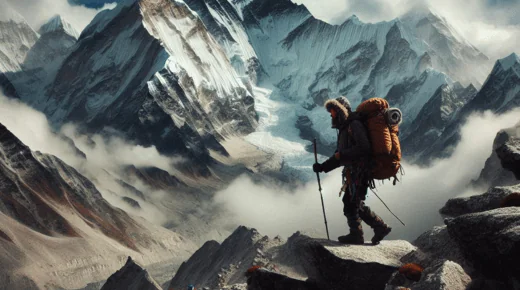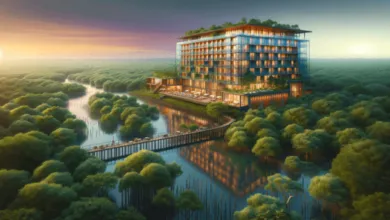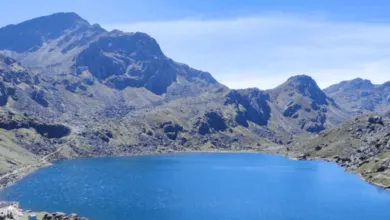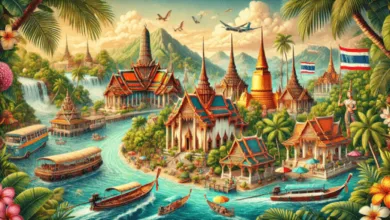Sherpa-Led Gokyo and Everest Base Camp Expedition A Journey of a Lifetime

Embarking on a Gokyo and Everest Base Camp trek with a Sherpa guide is an experience of a lifetime, a perfect fusion of adventure, cultural exploration, and breathtaking landscapes. As you walk deep into the heart of the Himalayas, the majestic mountains of Mount Everest, Lhotse, and Makalu seem to loom their presence over your journey. Approaching the trek, there is much more to savor than just reaching the lofty heights of the world’s tallest peak, which is also about drinking in the rich rhythms of the Sherpa culture, who have called these giant mountains home for centuries.
Your adventure starts in Lukla, where a Sherpa guide and a lineup of porters await to help blaze the trail. Their knowledge of the terrain and connection to the mountains make sure you are on the right trails and not going in circles. You will also see stunning villages of Sherpas on the way interact with the villagers and learn about their customs and hospitality. The Sherpas, famed for being both athletic mountaineers and every bit the kind, welcoming locals, are the invaluable personnel providing guidance on the trek.
Through verdant forests, over suspension bridges, and along rocky ridges, the landscape opens up over you as you follow your way up. The main highlight of the trip is reaching Everest Base Camp, where you will stand awestruck before the world’s highest mountain. The turquoise blue waters of the Gokyo Lakes make a serene and beautiful contrast against the rugged backdrop of Everest, with the snow-capped peaks of the mountains that surround it.
Your Sherpa guide will guarantee your security, oversee your acclimatization, and reveal the history and spirituality of the region throughout the expedition. Their expertise lets you enjoy the experience and know that you’re in good hands. Trekking to Gokyo and Everest Base Camp — Guided by Sherpas, this exciting trek offers challenging terrain, cultural experiences, and priceless memories.
About the Sherpa-Led Expedition
One of the most rewarding ways to experience the Himalayas — particularly in revered areas like Everest Base Camp and Gokyo Lakes — is to join a Sherpa-led expedition. Sherpas are an ethnic group from Nepal and are famous for their mountaineering skills and familiarity with the high-altitude conditions of the Himalayas. These experienced guides offer not only safety but also an authentic cultural experience, transforming a trek into much more than a physical challenge.
Everest base camp Trek Cost A trek with a Sherpa guide provides a level of trust and security; they possess valuable, local knowledge of the terrain, weather patterns, and altitudes. Sherpas hold a deep bond with the mountains and can read signs of altitude sickness and other health problems. The main purpose of any expedition is to guide the group safely, maintain a steady pace, attend to essential acclimatization, and the complete security of trekkers for the entire journey. In addition to being the best high-altitude climbers in the world, Sherpas also serve as cultural ambassadors, introducing trekkers to the traditions, beliefs, and lifestyles of the native people. Hiking to Everest Base Camp or the Gokyo Lakes, a Sherpa-led expedition is an unforgettable way to experience the stunning natural beauty and cultural richness of Nepal.
Why Choose a Sherpa-Led Trek?
Why You Should Choose a Sherpa-led Trek (Especially for High-Altitude Treks)To further grow your understanding of the Everest Region, high-altitude treks such as Everest Base Camp and Gokyo Lakes can be considered as the option to choose a Sherpa-led trek. One of the major benefits of all of this is safety. Sherpas are seasoned high-altitude workers, well adapted to the high-altitude environment of the Himalayas. They are trained to look for signs of altitude sickness and other health problems, providing much-needed first aid as needed and ensuring proper acclimatization.
EBC Cho La Pass Trek Sherpas also make sure backpackers trek at an appropriate rate, which helps acclimatize the body slowly to avoid altitude sickness. With local knowledge, they often prove indispensable when it comes to route planning, weather forecasting, and finding ways around whatever unexpected challenges trail life brings. But for pilgrims, travelers to high-altitude shrines like Everest, there’s a phrase that’s all the difference: in the company of a Sherpa, you have a guide, a gentle translator of the extremes, one who knows the land and the way, who helps put the edge back into your wick — whose very thread you might sport, knitted along your brow.
Another major advantage of trekking with a Sherpa is the cultural experience. As ambassadors of their communities, the Sherpa share their culture, spirituality, and local customs. Trekking in the Himalayas is therefore more of a process of discovery than just visiting a world heritage site. And for an immersive, safe journey through the Himalayas, a Sherpa-led trek is an excellent option.
Gokyo and Everest Base Camp Trek Highlights
Below are some about Gokyo and Everest Base Camp trek in Nepal, including dates, packages, the best time to travel, and things to do. This trip combines two of the most remarkable destinations in the Everest region: Everest Base Camp and the impressive Gokyo Lakes.
Everest Base Camp Trek Highlights Standing at the foot of the world’s tallest mountain- Mount Everest at Everest Base Camp. The hike to EBC is nothing short of breathtaking, as the hikers travel through fairytale villages such as Namche Bazaar, Tengboche, and Lobuche, where they meet Sherpa culture and some older monasteries there. The journey itself is iconic with stunning views of Everest, Lhotse, and other surrounding summits.
Another of its highlights is the Gokyo Lakes, a chain of high-altitude glacial lakes. These lakes, nestled amongst snow-capped peaks, present some of the most spectacular views in the Himalayas. The view from the top of Gokyo Ri includes breathtaking panoramic views of the Everest region and includes Everest, Cho Oyu, Makalu, and Lhotse.
One of the most popular adventures in the world is the hike, a blend of nature and cultural experiences. The Gokyo and Everest Base Camp trek is a once-in-a-lifetime challenge for people seeking a great adventure with beauty and culture.
Comparing the Trekking Routes: Gokyo or Everest Base Camp?
The Everest Base Camp trek and Gokyo Lakes trekare the most popular trekking routes in the Everest region of Nepal and offer different experiences. The Everest Base Camp trek is the more well-worn of the two, leading trekkers to the foot of Mount Everest, with bracing up-close views of the world’s highest peak, and hundreds of hours spent passing through Sherpa villages such as Namche Bazaar and Tengboche. It’s a fairly well-trodden route, with plenty of lodges and facilities along the way, resulting in palatable access to a wider range of trekkers.”
In contrast, the Gokyo Lakes trek is a somewhat more secluded journey, guiding trekkers through the tranquil and untouched scenery of the Gokyo Lakes, a collection of high-elevation freshwater lakes ensconced amid the soaring neighboring Himalayan peaks. The hike provides great views of Everest and surrounding peaks as well but from another angle. Gokyo Lakes Trek – One of the best features of the Gokyo Lakes trek is its summit of Gokyo Ri, which provides one of the most magnificent panoramic views of the Everest region that embraces Everest, Cho Oyu, and Makalu.
The Gokyo Lakes trek is a great alternative for trekkers looking for a slightly more peaceful and less crowded experience. However, most trekkers tend to do the combined treks for a complete Everest experience. In doing so, trekkers get to enjoy the iconic Everest Base Camp experience and get to enjoy the breathtaking beauty of Gokyo Lakes.
Climbing Sherpa: The Unsung Heroes Of Your Adventure
Sherpas are an invaluable part of any Himalayan trekking, especially when the route is as challenging as Everest Base Camp or Gokyo Lakes. Being native of the Khumbu region, Sherpas have a lot of local knowledge which is important for a safe and successful trip. It is thanks to their experience and expertise that most trekkers go unscathed, knowing they will not go off the beaten path or into areas where danger may lie.
Everest Base Camp via Gokyo Trek One of the most vital functions Sherpas serve is assisting trekkers in combating altitude sickness, a frequent worry when undertaking high-level hikes such as Everest Base Camp and Gokyo Lakes. Sherpas are trained to spot early symptoms of altitude sickness and how to respond quickly. They monitor the health of trekkers, modifying the pace of the trek and recommending rest days if needed so trekkers can acclimatize.
In addition to their navigational skills, Sherpas act as cultural guides, providing trekkers an opportunity to experience the customs, spirituality, and lifestyle of the Himalayan region. Their folk stories and history and local customs add more meaning, and immersion, to trekking. To many trekkers, Sherpas, whose skills, friendships, and companionship enliven the journey, are not just guides.
Efficacy of Acclimatization Methods to Treat Altitude Sickness
This is mainly because of the high altitudes, especially above the 5,000 mark (16,404 feet), like the Everest Base Camp and Gokyo Lakes trekking regions. Oxygen levels are lower and the risk of altitude sickness increases at such heights. This acclimatization process allows the body to adapt to the lower oxygen levels found at high altitudes, thus mitigating the risk of severe altitude sicknesses.
The “climb high, sleep low” strategy is the most common method used to acclimatize. This means hiking to a higher elevation during the day, then sleeping at a lower elevation, so that the body can acclimate slowly. Essentially, reflects the fact that trekking itineraries to this region tend to include an acclimatization day or two, built-in to provide trekkers with sufficient time to adapt to the thinning air before continuing to (higher) ground.
Gokyo to Everest Base Camp Trek Staying hydrated is another key to beating altitude sickness. Another tip is to drink more water while trekking because dehydration will speed up the symptoms of altitude sickness. Carbohydrates and high-calorie foods are also essential supplements for trekking the high altitudes.
Sherpas, are experts at handling acclimatization if you will and they are invaluable. They keep a close eye on trekkers for symptoms of altitude sickness and make sure the pace is appropriate for adequate acclimatization. By using these strategies, and readily heeding Sherpas, trekkers can greatly lower their odds of altitude sickness — so there exists less suffering and a safer and more comfortable jaunt.
Getting Physically Prepared for the Trek
With difficult terrain and high altitudes, physical preparation will be an integral part of your trek to Everest Base Camp and Gokyo Lakes. To prepare for the challenging trek, focus on building your cardiovascular endurance, strength, and stamina. Improve stamina with regular aerobic conditioning, forcing both your lungs and legs to adapt to longer days of walking at changing altitudes, via activities like running, swimming, cyclin,g and hiking. Training with a backpack is also helpful since you’ll be carrying essential gear throughout the trek. Steep climbs and descents will call for musculature that squats, lunges, and leg presses will help develop.
Flexibility contributes to injury prevention (particularly crucial in a region like this one with rugged terrain), along with cardiovascular fitness and strength. Do some stretching, yoga, or pilates, which will improve balance and flexibility, both of which become important when walking on uneven terrain. As well, slowly increasing your level of physical activity is also very important to prevent yourself from overdoing it during the climb. Alternatively, practicing at higher elevations or in conditions with less oxygen will also help acclimatize your body. Finally, be prepared mentally; walking high is mentally difficult; stay positive a be patient to keep you motivated and enjoyed.
The Gear You Need to Bring and How to Pack It
Gokyo Everest Base Camp Trek cost Gear List for Trek to Everest Base Camp and Gokyo Lakes You are trekking to Everest Base Camp and Gokyo Lakes — get this gear and more preparation for a trek for Everest Base Camp & Gokyo Lakes is not an easy task! Start with clothes — layering is essential in the uncertain weather of the Himalayas. Begin with base layers that wick away moisture and keep you dry and comfortable. Typically you’ll have a base layer (long sleeve shirt and pants), an insulation layer (a good fleece or down jacket for warmth), and then a waterproof and windproof outer layer to help protect you from rain, snow, and cold winds. For your feet, solid, high-ankled trekking boots with good tread are a must for going up steep and rocky ground, and several pairs of moisture-wicking socks are a necessity to prevent blisters.
A lightweight, well-fitted backpack will be needed for carrying essentials such as water, snacks, and a first-aid kit. Trekking poles will help with balance and take some pressure off your knees, particularly on steep descents. For camping, where relevant, a good-quality sleeping bag with a low-temperature rating, as nighttime can be cold at high altitudes. And a headlamp or flashlight with backup batteries will be invaluable for early starts or late arrivals. Remember the basics: sunscreen, sunglasses, a hat, a camera, and a portable charger.
Safety first: take a first-aid kit which should include bandages, antiseptic wipes, painkillers, and altitude sickness medicine. Carry a water purifier or carry purification tablets to ensure safe drinking water. Packing these things will guarantee that you’re ready to hit the trail, so you can main on the adventure.
On The Trail: Sherpa Culture And Traditions
Hiking through the Everest region is a great way to experience the rich Sherpa culture and traditions. Native to the Khumbu region of Nepal, the Sherpa people have a profound spiritual and cultural connection to the mountains. The Himalayas provide natural wonder and difficulty in equal measures; their grit and hospitality are legendary. Sherpas follow Tibetan Buddhism, which has a deep influence on their daily rituals, community life, and engagement with trekkers.
You’ll also come across many Buddhist monuments like stupas, mani walls, and prayer flags, which are an important part of Sherpa culture. Prayer flags flutter in the winds sending prayers to the mountains and these sacred objects are believed to hold powers of blessing and protection. The Sherpas hold the concept that the mountains are sacred entities, especially Mount Everest, as an important part of their identity. Indeed, many Sherpas participate in ceremonies to pray for the gods of the mountains’ blessings before undertaking difficult climbs.
Sherpas are also known for their hospitality and warmth. Along the trek, visitors are frequently welcomed into homes or teahouses where they’re offered traditional foods, including dal bhat (lentils and rice) and butter tea. The Sherpas guide trekking offers an in-depth cultural insight into their close-knit lifestyle. Trekking with Sherpas also provides an added layer of safety as they know the Everest region inside and out – from the terrain to the weather patterns.
SURVIVING PERMITS AND REGULATIONS
Trekking in Nepal, be it Everest Base Camp or Gokyo Lakes, you need to know and navigate the permits and requirements to enjoy a legal and hassle-free trek! The two main permits needed are the Sagarmatha National Park Permit and the TIMS (Trekkers’ Information Management System) Card. Entry into the national park (covering both Everest Base Camp and the Gokyo Lakes region) is subject to having a Sagarmatha National Park Permit. This permit, which supports the conservation of the area, costs approximately USD 30 for international trekkers.
Gokyo and Everest Base Camp Trek price In addition, all trekkers are required to have a TIMS card, and it also allows the government to track visitors in the area. You get this card through registered long trek agencies. You may require additional permits, depending on your specific route such as if you’re heading to Gokyo Lakes or other restricted zones.
Permits can be obtained in Kathmandu through trekking agencies or at the Nepal Tourism Board. As there are checkpoints along your route that will need to see your permits, it’s best to make sure you have all the necessary paperwork sorted out before you start your trek. Fines are tangible, so ensure that your actions do not breach environmental or cultural norms or rules kamat-kamat culture, killing, or even mam! Most of the paperwork will be handled by a licensed guide or trekking agency, allowing you to focus on the adventure, while making sure that you trek legally.
Emergency Procedures and Safety Protocols
When trekking in the Everest region, your safety comes first, especially at such high rates of altitude and hard terrain. Among the major threats is altitude sickness, which can affect trekkers at elevations of 2,500 meters and higher. Proper acclimatization is, therefore, highly essential to prevent this. Most hikes in the Himalayas can be done in a gradual ascent and then you would take rest days at certain altitudes for your body to acclimatize to the thin air. Symptoms of altitude sickness include headache, dizziness, nausea, and fatigue, and if any of these arise, it’s crucial to descend to a lower altitude immediately.
One of the best ways to ensure safety is to trek with an experienced Sherpa guide. Sherpas are experienced in navigating the terrain, and trained to detect early symptoms of altitude sickness. They also know how to respond in emergencies, whether that means evacuating trekkers to a lower altitude or coordinating rescue operations if needed. Generally, It is recommended to travel with a trustworthy trekking agency that offers alternative communication devices such as satellite phones, as remote places could have limited access to medical services.
A well-stocked first-aid kit is also crucial, with medications for altitude sickness, pain relief, blister treatment, and antiseptic wipes. It helps to know where nearby medical facilities are, and what to do in case of serious injury or illness, too. Safety on the trek can be managed well with the right precautions, and training, and Sherpa guides are experts in keeping you safe.
Make Sure to Make Your Adventure Unforgettable
Here are some tips to make your Gokyo Lakes and Everest Base Camp trek memorable and successful. The studio is not very precise, so take your time and enjoy it. The journey itself is a highlight, with breathtaking vistas, charming villages, and a culture filled with great excitement. Keep a steady pace, don’t rush — let your body acclimate properly, particularly as you increase in elevation.
Another helpful tip is packing wisely. Even though it is tempting, bringing everything is not recommended, best to pack lightly carrying the essentials such as good clothing layers, sturdy boots, and hygiene items. Avoiding fatigue and sore backs on long days of trekking, a lightweight backpack will be a dream. You’ll need a good-quality camera to capture the breathtaking views, but be sure to leave room in your bag for practical gear.
Be willing to adjust plans for changing weather conditions. Weather in the Himalayas can be erratic, so you should be equipped with rain, snow, or extreme cold gear. Roll with the punches, and trust your Sherpa guide to make changes if and when needed.
Finally, take the time to get to know the local culture and the Sherpas on the way. Their hospitality and knowledge of the area will enhance your experience and provide broader insights into the places you are visiting. If you remain positive, well-prepared, and have an open mind, your expedition will not only be physically rewarding but also culturally enriching and absolutely unforgettable.



